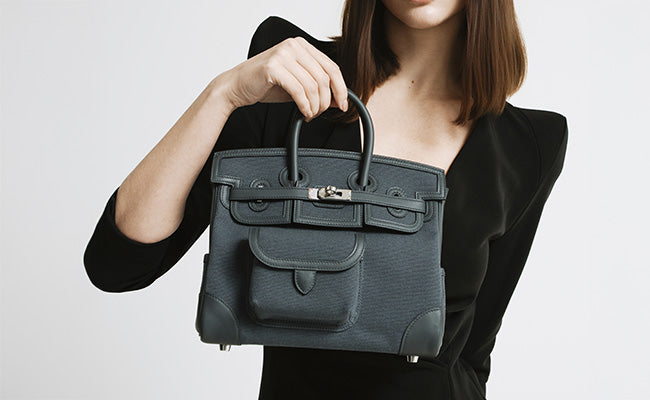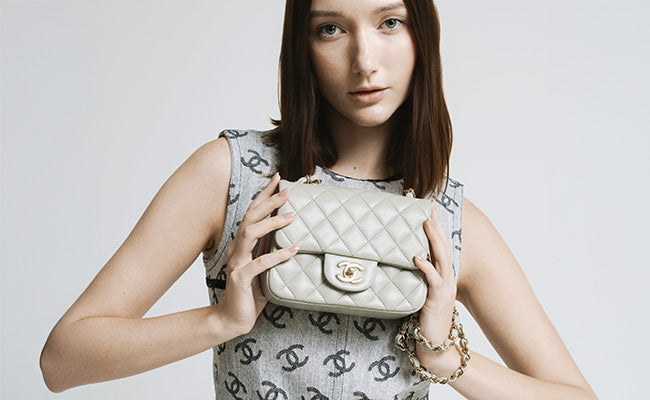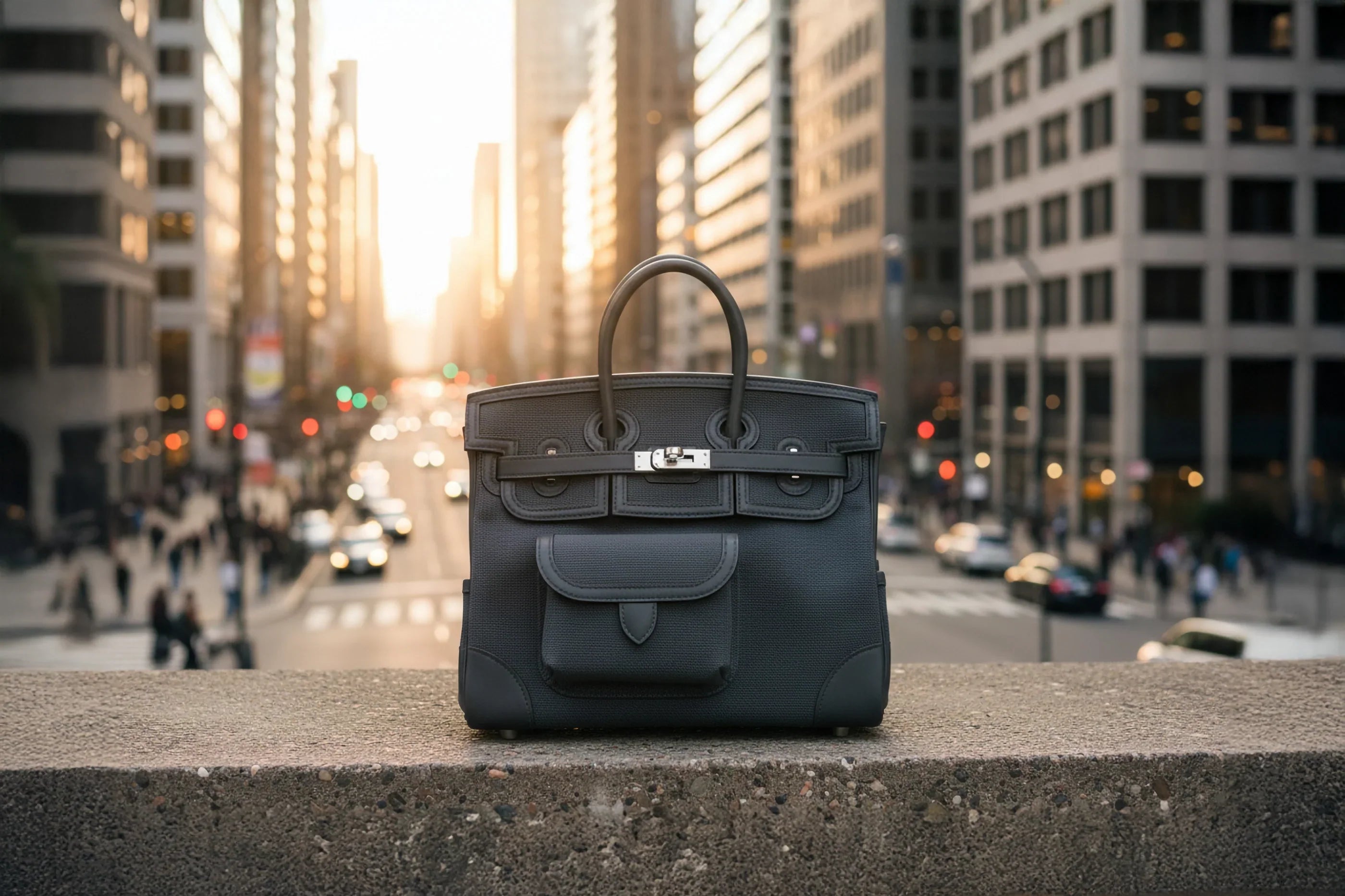
Barenia & Barenia Faubourg: Embracing Patina the Right Way
Check out our Hermès collection and Birkin bags!
Barenia and Barenia Faubourg are Hermès at their most genuine - leathers that get better with age, turning everyday use into something beautiful.
These aren’t those fussy luxury materials that make you nervous to touch them; they’re living leathers, thriving on wear, collecting stories through every bump and scratch.
Patina, in this world, isn’t just about getting old - it’s a transformation that happens when the right leather meets the right kind of care.
Most luxury leathers fear wear, but Barenia leans into it, developing a glossy, rich patina that makes each piece truly yours. Barenia Faubourg, which Hermès launched in 2017, is a grained spin on the original - more scratch-resistant, but still aging gracefully.
People love to share stories about curry stains vanishing into a gorgeous patina or scratches melting into the leather’s evolving personality. But it’s not just luck.
There’s a method to the magic, from the double-tanning process to the specific way you care for these leathers so they reach their potential.
Key Takeaways
- Barenia gets more beautiful the more you use it. Everyday wear actually helps its appearance.
- Barenia Faubourg has the same patina magic but is tougher, thanks to its grainy texture.
- Proper care means letting the leather age naturally, but also keeping it healthy with the right conditioning and handling.
What Is Barenia & Barenia Faubourg Leather?
Barenia is Hermès’ most storied leather, rooted in equestrian tradition and loved for its living patina. Barenia Faubourg is a modern twist - same heritage, but with extra durability for today’s luxury bags.
Barenia Origins and Hermès Heritage
Barenia goes back to Hermès’ saddlery days, made for gear that needed to be both tough and supple. This calf leather was built to handle the demands of horse riding and to get better with time.
It feels buttery-soft, a bit oily, and you’ll spot it by its signature white saddle stitching - a nod to its equestrian roots.
What really sets Barenia apart is how it handles wear. Instead of obvious damage, scratches and marks blend right in, building a deep, glossy patina. It’s “living leather” - the more you use it, the more personal and beautiful it gets.
Fauve is the iconic Barenia color. That warm tan shade deepens dramatically over years of handling.
Barenia Faubourg's Place in the Hermès Lineup
Hermès brought out Barenia Faubourg in 2017, naming it after their flagship Paris boutique. This version tackled some of the practical worries about traditional Barenia but kept its essential character.
Barenia Faubourg comes with a mildly grained texture, making it more scratch-resistant than the smooth original. The subtle pebbling gives the leather structure but still lets it develop a patina.
It feels more substantial than other Hermès leathers like Togo. The grain pattern looks less formal than smooth Barenia, but more refined than the heavily textured options.
You’ll find Barenia Faubourg in colors like Ebene and Natural, not just the classic Fauve.
How Barenia Compares to Other Calf Leathers
Here’s a quick look at how Barenia stacks up against other calf leathers:
| Leather Type | Texture | Patina Development | Scratch Resistance |
|---|---|---|---|
| Barenia | Smooth, oily | Dramatic, glossy | Low |
| Barenia Faubourg | Mildly grained | Moderate | Medium |
| Togo | Heavily grained | Minimal | High |
Barenia needs more thoughtful handling than Togo or Clemence. It shows every touch, which some collectors love and others find a bit intimidating.
The patina is what really sets Barenia apart. Togo stays pretty much the same, but Barenia morphs into something unique to each owner’s habits and lifestyle.
The Allure of Patina: Why It Matters
Patina takes Barenia leather from “nice” to “extraordinary.” Both Barenia and Barenia Faubourg develop this sought-after character, turning each piece into a visual diary.
How Patina Develops on Barenia
Barenia’s patina comes from its double-tanning process - chrome and vegetable dyes - followed by a long soak in a mix of nine oils. This is what sets up its signature aging.
Natural oils from your hands speed up the patina. Every touch adds to the leather’s richness and depth. No two pieces end up the same.
How fast it happens? That depends. Light use means slow, subtle changes. Heavy use, and you’ll see the patina start to pop within weeks.
Light and humidity matter too. Sun and changing weather help the leather evolve, though you still want to keep it away from too much moisture.
Unique Character and Appeal
Patina brings depth and richness you just can’t get from new leather. The surface picks up subtle color changes and a sheen that catches the light.
Every bag tells its own story with patina. Handles darken first, then corners and edges - these maps of use become a kind of fingerprint.
There’s something special about owning a well-patinated piece. Anyone can buy a new Hermès bag (if you’re lucky enough to get one), but a perfectly aged one? That’s years in the making.
Collectors go after bags with great patina because it proves the leather is doing exactly what it’s supposed to. It’s a testament to Hermès’ leather expertise.
Patina on Birkin and Hermès Icons
Birkins really show off patina, thanks to their big surface and all the handling points. The front flap, handles, and corners change first.
Classic Barenia Birkins are especially prized for patina potential. The smooth surface makes the color evolution dramatic - every transformation is obvious and striking.
Barenia Faubourg Birkins develop patina too, just more subtly. The grainy texture creates a gentle contrast as the color deepens.
Authentication experts even look at patina patterns when checking vintage pieces. Real aging creates wear patterns that fakes just can’t copy.
Tanning Process: The Secret Behind the Patina
Barenia’s legendary patina starts with a unique double-tanning process - chrome and vegetable dyes - then weeks of oil saturation. This is what gives the leather its ability to absorb scratches and build character.
Vegetable Tanning Techniques
Vegetable tanning is the backbone of Barenia’s aging magic. It uses natural tannins from tree bark, leaves, and other plants.
Raw calfskin soaks in stronger and stronger tannin solutions, slowly transforming the hide and laying the groundwork for patina.
What’s special here is how the vegetable tanning interacts with the later oil treatment. The tannins create tiny pockets in the fibers that soak up the nine oils Barenia gets at the end.
That’s why Barenia’s patina is so rich and deep compared to chrome-only leathers. The vegetable tannins feed the aging process, letting the leather darken and develop complexity over time.
The Double-Tanning Method Explained
Barenia’s double-tanning is almost legendary - only a handful of craftspeople know the full process.
Chrome tanning comes first, giving durability and flexibility. Then vegetable tanning adds the patina-building magic.
After tanning, the leather soaks up nine different oils for 5-6 weeks. Each oil has a job, whether it’s helping resist scratches or building a certain finish.
The oils fill tiny gaps in the leather, so when you rub a scratch, it can actually disappear. Hermès calls this the “magic” of Barenia.
The whole process takes months, which is a big part of why Barenia is so expensive and rare.
Barenia vs. Barenia Faubourg: Key Differences
Both leathers share Hermès DNA and that unmistakable craftsmanship, but they’re pretty different in practice. The main differences? Texture, protection, and how they age.
Surface Texture & Feel
You’ll notice the difference right away. Classic Barenia is buttery-smooth with a soft gloss - your fingers just want to linger.
Barenia Faubourg, though, has a mildly grained surface, more like Togo or Clemence. It’s Barenia’s textured cousin.
Both feel substantial, but Faubourg is actually a bit more supple and flexible. The grain gives it a different kind of depth.
And yes, they both pass the “sniff test.” That Hermès leather scent is there, no matter the finish.
Water and Scratch Resistance
Here’s where it gets a little weird. Classic Barenia is surprisingly water-resistant - you can use it in light rain and not worry too much.
Barenia Faubourg, despite being newer, is actually less water-resistant. The grained surface seems to compromise that protective quality a bit.
For scratches, the roles reverse. Smooth Barenia shows every mark, though you can usually rub out light ones with your fingers. Barenia Faubourg’s grain hides scratches much better.
The texture acts like camouflage for daily wear. That makes Faubourg a bit more practical, especially if you’re not keen on seeing every little mark.
Patina Evolution Comparison
Both leathers develop patina, but the journey’s a bit different. Classic Barenia ages fast and dramatically - color changes show up within months.
Every touch and oil transfer from your hands speeds up the process. Handles and corners darken first, and it’s easy to see.
Barenia Faubourg’s patina comes in more gradually and evenly. The grain spreads out the wear, so you get a subtler evolution.
After months of use, Faubourg deepens in color, but you won’t see the bold contrasts you get with smooth Barenia. It’s a question of taste - do you want drama, or something more understated?
Living With Barenia: Everyday Use and Lifestyle
Choosing Barenia means making peace with its quirks across different products, from Birkins to watch straps. The trick is to set real expectations and embrace the aging that makes each piece yours.
Bags, Small Leather Goods & Watch Straps
Bags like the Birkin or Picotin in Barenia need a little more care than Togo. The surface is softer, more reactive, and it shows life’s moments.
Smooth Barenia picks up patina faster than Faubourg. The grain on Faubourg helps hide small scratches, but both versions darken and gain character over time.
Small Barenia goods - wallets, cardholders - are great for occasional use. They develop a beautiful patina from handling.
Watch straps in Barenia are incredibly comfortable and flexible. They mold to your wrist and pick up rich color from daily wear.
Barenia’s water resistance works for everyday life, but don’t push it - avoid soaking or prolonged exposure. The natural oils help repel moisture and keep the leather supple.
Expectations for Wear and Tear
Scratches show up fast on Barenia. That’s just how it is. Light scratches often disappear with a gentle rub or a soft horsehair brush.
Barenia Faubourg handles daily life better, thanks to its texture. Both types soak up marks and scratches into the patina rather than showing them as permanent damage.
Color changes happen slowly. Fauve Barenia shifts from light tan to a deep cognac with use.
Regular moisturizing helps fend off deeper scratches and keeps the leather soft. Go for conditioners made for vegetable-tanned leather.
Beneath the soft surface, the double-tanning gives real durability. Barenia might look delicate, but it’s built to handle regular use - as long as you treat it with a bit of respect.
Letting Go of Perfectionism
Barenia has this way of teaching you to see beauty in imperfection. Those first scratches? They sting at first, but honestly, they're just the start of your bag's own story.
Every little mark adds to the character. What you worry about now ends up being what makes the bag feel like yours.
Instead of obsessing over keeping it pristine, try living with it. Barenia leather isn't meant for a museum shelf - it wants to be out in the world.
Bags that get regular use develop the most beautiful, even aging patterns. The patina process really rewards the ones that see life, not just careful storage.
Hermès craftsmen actually designed Barenia to get better as it ages. If it's sturdy enough for their heritage saddles, it's definitely up for the challenge of your daily routine - once you let go and let it evolve.
Care and Maintenance Tips for the Perfect Patina
Caring for barenia leather means using gentle methods and solid products to help it develop that coveted patina - without risking the delicate surface. Regular conditioning and smart storage can keep your investment piece aging gracefully and holding up over time.
Cleaning and Conditioning
Start with a soft, lint-free cloth to wipe away surface dust and dirt. Don’t reach for harsh chemicals or typical leather cleaners - barenia’s unique tanning makes it more sensitive than most leathers.
For deeper cleaning, a barely damp cloth with distilled water does the trick. Work in small areas and dry right away with a clean cloth.
Conditioning? Every 3-4 months is enough, and only with a high-quality leather moisturizer made for luxury handbags. Use a soft cloth and gentle, circular motions - don’t overdo it.
Supplies you’ll want:
- Lint-free microfibre cloths
- Premium leather conditioner
- Soft horsehair brush
- Distilled water
Go easy on the conditioner. Too much and the oils can migrate, which you don’t want. Let the leather rest for a full day after conditioning before you use it again.
Dealing with Scuffs, Scratches, and Stains
Light scratches usually disappear if you gently rub them with your fingers or a soft cloth. The leather’s natural oils help blend minor marks right into the developing patina.
If you run into deeper scratches, try a soft horsehair brush with gentle, circular strokes. That can help redistribute the oils and make damage less obvious.
For water spots, blot gently with a dry cloth and let the leather air dry - don’t use a hair dryer or any heat, or you’ll risk permanent damage.
Ink or makeup stains? Honestly, leave those to the professionals. DIY fixes on barenia almost always make things worse and can mess up the patina for good.
Never do this:
- Sand or buff scratches
- Use commercial stain removers
- Apply heat to dry wet spots
How to Store and Preserve Character
Keep your barenia leather bag in its original dust bag, stored somewhere cool and dry and out of direct sunlight. Too much heat or humidity can mess with the natural patina process.
Stuff the bag with acid-free tissue paper to help it keep its shape. Skip newspaper or colored tissue - those can leave marks or transfer dye onto the leather inside.
If you’ve got a collection, rotate your bags now and then. Barenia actually benefits from occasional use - the oils from your hands help build an even patina.
Protect your bag from sharp objects, zippers, and rough surfaces. Store each piece separately to avoid color transfer or scratching.
If you’re not using your bag for six months or more, check in on it monthly. Take it out of the dust bag for a few hours so it can breathe.
Frequently Asked Questions
Barenia leather brings its own set of quirks and rewards. If you want that honey-colored patina or just want to know how to handle daily wear, here are some of the most common things people wonder about.
What's the secret to developing a gorgeous patina on a Barenia leather bag over time?
Honestly, it’s all about regular use and gentle handling. Oils from your hands, a bit of sunlight, and daily wear do most of the work.
Don’t try to rush things with extra oils or constant conditioning. The leather darkens and deepens naturally over months and years - patience pays off.
Try to handle your bag with clean hands. Natural skin oils are great, but dirt and lotions can cause weird, uneven patina that isn’t as nice to look at.
How does Barenia Faubourg differ from the classic Barenia in terms of texture and ageing?
Barenia Faubourg has a subtle grain, so it resists scratches better than the smooth classic Barenia. That texture helps hide little marks that would be obvious on the smooth version.
Patina develops more gently and evenly with Faubourg. Classic Barenia, on the other hand, changes dramatically - every scratch and scuff becomes part of the story, giving it a deep, glossy look that’s hard to fake.
Can you give some tips for first-time owners on caring for Barenia leather goods?
Keep it away from water as much as you can. Barenia doesn’t like moisture - it can stain and the patina might develop unevenly.
Store your bag in its dust cover when you’re not using it. Sunlight can speed up color changes and might not give you the look you’re hoping for.
If you get small scratches on classic Barenia, don’t stress. They’ll blend in with time and add to the bag’s unique character.
What makes Barenia leather a go-to choice for those seeking a rich, natural look in high-end accessories?
Barenia feels alive. The way it changes connects you to your bag - every piece ends up looking different, shaped by how you use and care for it.
Hermès’ roots in saddlery give Barenia real authenticity. It was designed for tough equestrian life, so there’s a genuine history behind the luxury.
The contrast white stitching on Barenia is a nice touch. It pops against the smooth leather and stands out even more as the patina develops around it.
How do climate conditions affect the patination process of Barenia leather items?
Humidity speeds up patina, but it can also make the color develop unevenly. Try to avoid super humid places, especially in the first few months.
Dry climates slow the process but give you more predictable results. Moderate, steady humidity is best for a controlled patina.
Big temperature swings make the leather expand and contract, which can speed up wear and change how the patina forms in stressed spots.
Could you recommend the best Hermès bag models that showcase Barenia leather's unique charm?
The Kelly really brings out Barenia's appeal. Its structured silhouette and big, smooth flap let the leather's patina stand out over time.
Birkins in Barenia? They're hard to beat. The roomy design means there's a lot of leather on display, so you get to watch the patina shift and deepen as the bag ages.
Garden Party bags give you a more laid-back way into Barenia. Their casual shape pairs nicely with the leather's tendency to develop character with use.




